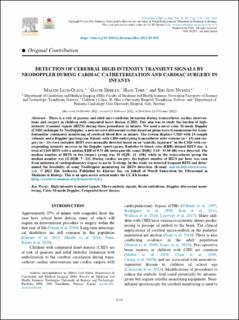| dc.contributor.author | Leth-Olsen, Martin | |
| dc.contributor.author | Døhlen, Gaute | |
| dc.contributor.author | Torp, Hans | |
| dc.contributor.author | Nyrnes, Siri Ann | |
| dc.date.accessioned | 2022-12-09T14:24:36Z | |
| dc.date.available | 2022-12-09T14:24:36Z | |
| dc.date.created | 2022-04-22T10:35:16Z | |
| dc.date.issued | 2022 | |
| dc.identifier.citation | Ultrasound in Medicine and Biology. 2022, 1-12. | en_US |
| dc.identifier.issn | 0301-5629 | |
| dc.identifier.uri | https://hdl.handle.net/11250/3037058 | |
| dc.description.abstract | There is a risk of gaseous and solid micro-embolus formation during transcatheter cardiac interventions and surgery in children with congenital heart disease (CHD). Our aim was to study the burden of high-intensity transient signals (HITS) during these procedures in infants. We used a novel color M-mode Doppler (CMD) technique by NeoDoppler, a non-invasive ultrasound system based on plane wave transmissions for transfontanellar continuous monitoring of cerebral blood flow in infants. The system displays CMD with 24 sample volumes and a Doppler spectrogram. Infants with CHD undergoing transcatheter interventions (n = 15) and surgery (n = 13) were included. HITS were manually detected based on an “embolic signature” in the CMD with corresponding intensity increase in the Doppler spectrogram. Embolus-to-blood ratio (EBR) defined HITS size. A total of 1169 HITS with a median EBR of 9.74 dB (interquartile range [IQR]: 5.10–15.80 dB) were detected. The median number of HITS in the surgery group was 45 (IQR: 11–150), while in the transcatheter group the median number was 12 (IQR: 7–24). During cardiac surgery, the highest number of HITS per hour was seen from initiation of cardiopulmonary bypass to aortic X-clamp. In this study we detected frequent HITS and determined the feasibility of using NeoDoppler monitoring for HITS detection. | en_US |
| dc.language.iso | eng | en_US |
| dc.publisher | Published by Elsevier Inc. on behalf of World Federation for Ultrasound in Medicine & Biology. | en_US |
| dc.rights | Navngivelse 4.0 Internasjonal | * |
| dc.rights.uri | http://creativecommons.org/licenses/by/4.0/deed.no | * |
| dc.title | Detection of Cerebral High-Intensity Transient Signals by NeoDoppler during Cardiac Catheterization and Cardiac Surgery in Infants | en_US |
| dc.title.alternative | Detection of Cerebral High-Intensity Transient Signals by NeoDoppler during Cardiac Catheterization and Cardiac Surgery in Infants | en_US |
| dc.type | Peer reviewed | en_US |
| dc.type | Journal article | en_US |
| dc.description.version | publishedVersion | en_US |
| dc.source.pagenumber | 1256-1267 | en_US |
| dc.source.volume | 48 | en_US |
| dc.source.journal | Ultrasound in Medicine and Biology | en_US |
| dc.source.issue | 7 | en_US |
| dc.identifier.doi | 10.1016/j.ultrasmedbio.2022.02.021 | |
| dc.identifier.cristin | 2018353 | |
| cristin.ispublished | true | |
| cristin.fulltext | original | |
| cristin.qualitycode | 2 | |

